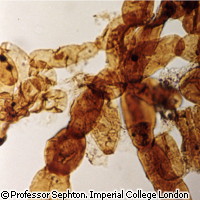Mass extinction helped ancient fungi thrive
The mass devastation of Earth's forests 250 million years ago was the catalyst for a fungal explosion, according to a new international study published in the journal Geology. The researchers said the tiny organisms, called Reduviasporonites, emerged and proliferated across the globe following the wipeout. Led by Imperial College London in the UK, the researchers evaluated the carbon and nitrogen content of the fossilised remains of the Reduviasporonites, and classified them as a type of wood-rotting fungus that made their home inside dead trees. The British, Dutch and American researchers used high-sensitivity equipment designed in part to detect interstellar grains in meteorites, to have another look at the geochemical signature of Reduviasporonites. They compared their results with those from modern fungi and found that Reduviasporonites and modern fungi have similar chemical characteristics. Their observation cemented what researchers in the past were unsure of: are these tiny organisms a type of fungus or algae? 'Organic chemistry, carbon and nitrogen isotopes, and carbon/nitrogen ratios are consistent with a fungal origin,' the study's authors wrote. Their finding also lays to rest the theory that an asteroid impact was probably responsible for the massive destruction across Pangaea, the supercontinent consisting of all Earth's land masses that existed during the Palaeozoic and Mesozoic eras. 'This [fungus] was a disaster species, something that perhaps enjoyed the extinction a little more than it should,' explained Professor Mark Sephton of the Impacts and Astromaterials Research Centre at Imperial College. 'It proliferated all over the globe.' According to the researchers, fossil records of Reduviasporonites show chains of microscopic cells and are a sign that these organisms thrived during the Permian-Triassic period - considered the severest global catastrophe ever experienced on Earth. Up to 96% of all marine species and 70% of land species were wiped out during this period. Data show that the continent was hit by basalt lava (hard and black volcanic rock formed from liquid lava) flows from the location now known as Siberia in Russia. The study's results suggest that extensive vegetation on Pangaea was lost following the mass extinction. Geological records also indicate that the population of Reduviasporonites grew across Pangaea as the Permian period entered its last stages. 'Our study shows that neither plant nor animal life escaped the impact of this global catastrophe,' Professor Sephton said. 'Ironically, the worst imaginable conditions for plant and animal species provided the best possible conditions for the fungi to flourish.' The researchers speculate that basalt lava unleashed toxic gases and effectively 'choked' the atmosphere. These gases succeeded in producing acid rain and in depleting the ozone layer. Ultimately, the total destruction of forests fuelled the growth of the tiny organisms, as they feasted on the rotting vegetation. The next step for the researchers is to carry out further comparisons between Reduviasporonites and potential counterparts among modern fungi. They believe their work will offer more clues about how the ancient organisms lived.
Countries
Netherlands, United Kingdom, United States



